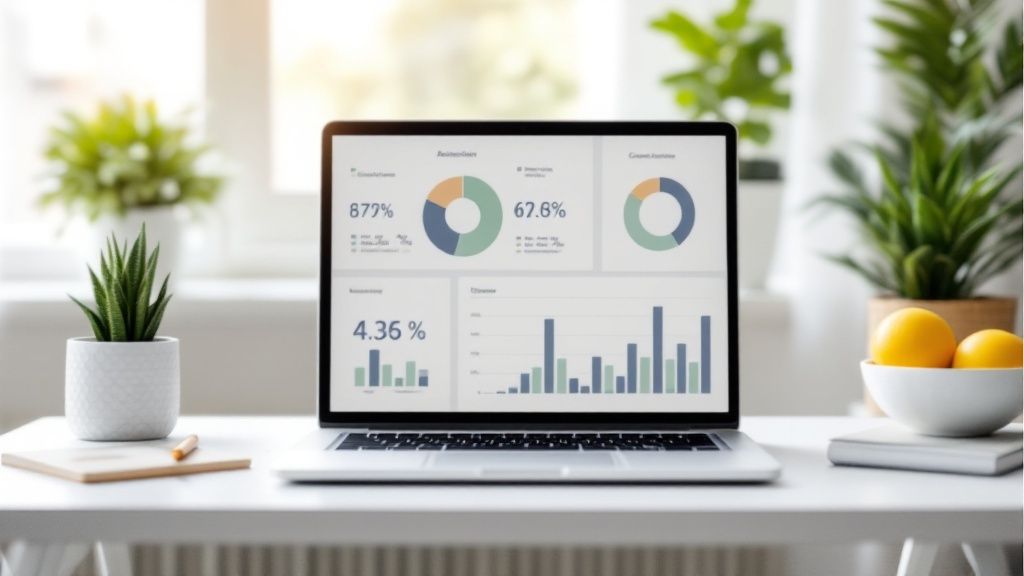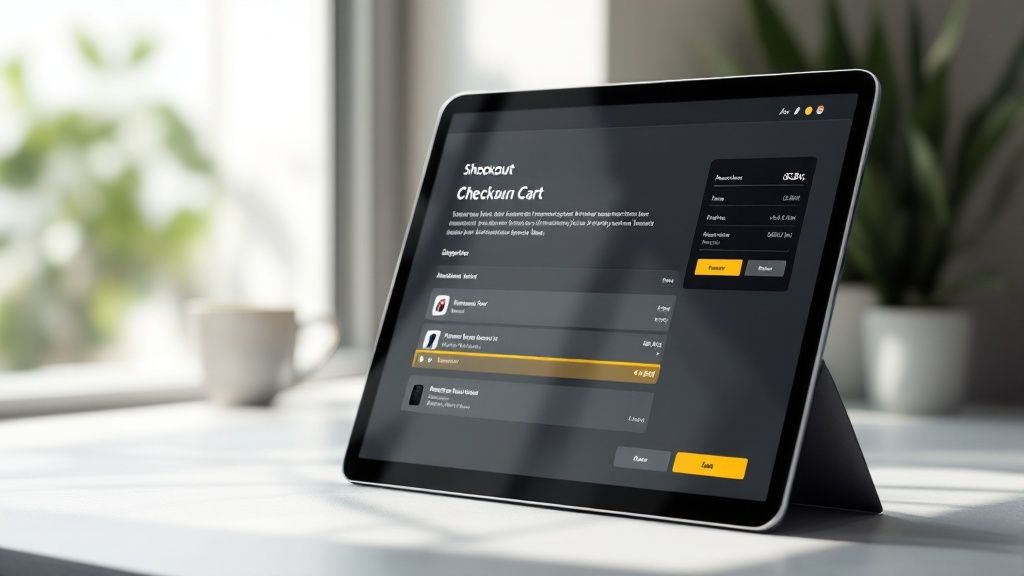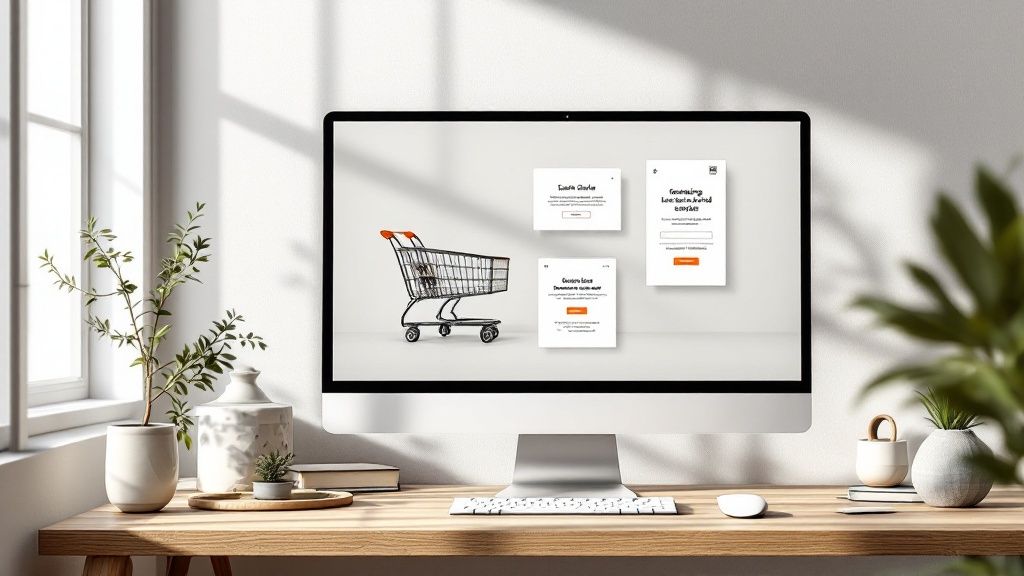How to Fix Shopify Abandoned Checkout: Data-Driven Strategies That Work
February 1, 2025

Understanding the True Cost of Cart Abandonment

Every time a customer abandons their cart on your Shopify store, you lose more than just a potential sale. The real cost includes all the marketing spend, website development, and other resources invested to get that customer to your checkout page. When they leave without purchasing, those investments yield no return.
The Financial Impact of Abandoned Checkouts
Think of abandoned carts as money slipping through your fingers. For a store making $100,000 in monthly sales with a 70% abandonment rate, that's $70,000 in potential revenue left on the table each month. This lost income could fund growth initiatives or store improvements. Plus, high abandonment rates can skew your marketing data, making it harder to measure campaign success and optimize your advertising budget.
The problem is getting worse across the industry. The Baymard Institute reports that the global cart abandonment rate hit 70.19% in 2023, up from 68.07% in 2014 and 69.99% in 2022. For more eye-opening statistics, check out Omnisend's detailed cart abandonment report. These numbers show that this is a critical issue requiring immediate attention from online retailers.
Beyond the Numbers: The Customer Perspective
To fix cart abandonment, we need to understand why customers leave before buying. Common issues include complex checkout flows, surprise shipping costs, and limited payment options. Simply trying to recover abandoned carts without addressing these root causes won't solve the problem long-term.
You might be interested in: How to reduce cart abandonment with proven strategies
Turning Challenges into Opportunities
Each abandoned cart is a chance to improve your store and win back sales. Start by sending targeted recovery emails, offering strategic discounts, and making your checkout process smoother. Small improvements can lead to significant gains in completed purchases. Tools like Checkout Links can help automate this process, making it easier to convert abandoned carts into completed orders.
Breaking Down the Abandonment Decision Journey

When customers abandon their online shopping carts, it impacts both your revenue and conversion rates. To address this challenge effectively, you need to understand exactly what causes shoppers to leave before completing their purchase. This is especially critical for Shopify store owners who want to minimize lost sales opportunities.
Understanding Friction Points in the Shopify Checkout
The path from product discovery to purchase completion has several key stages where customers might drop off. A typical journey includes browsing product pages, adding items to cart, entering shipping details, selecting payment methods, and confirming the order. At each of these points, customers can encounter obstacles that make them reconsider their purchase. For instance, a complicated checkout form or unclear shipping options can quickly lead to abandonment.
The Psychology of Abandoned Checkouts
Customer psychology plays a major role in checkout completion. Some shoppers respond well to limited-time offers that create urgency, while others may leave if they feel pressured. Trust is also essential – customers need to feel confident about sharing their payment information and understanding your return policy. When shoppers are unsure about either aspect, they're more likely to abandon their cart.
Hidden Costs and Transparency: A Key Factor in Abandonment
Unexpected costs are one of the biggest reasons shoppers abandon their carts. According to recent data, 47% of customers leave when they encounter surprise fees at checkout. This includes shipping charges, taxes, and other additional costs that weren't clearly displayed earlier. For more insights on cart abandonment, check out Shopify's detailed analysis. To combat this, consider showing all costs upfront or offering free shipping above certain order values. By removing these common friction points and being transparent about pricing, you can significantly reduce your cart abandonment rate and improve your store's conversion rate.
Mastering Global and Device-Specific Conversion Optimization

Creating an effective Shopify checkout process requires understanding how customers in different regions shop and what device they use to make purchases. By analyzing these patterns, you can make smart adjustments that reduce abandoned carts and increase sales.
Localization: Adapting to Regional Preferences
What works for customers in one country often falls flat in another. This is especially true for payment methods, shipping expectations, and return policies. For example, while US shoppers often expect free shipping, this may not be standard in other markets. That's why it's crucial to customize your abandoned checkout Shopify recovery emails based on location.
Language also plays a key role in checkout completion rates. By offering checkout pages in multiple languages through Shopify's built-in tools or translation apps, you can create a smoother experience for international customers. For instance, using Checkout Links lets you send recovery emails in the shopper's language with their cart details already filled in, making it easier for them to complete their purchase.
Device Optimization: Mobile-First Approach
Mobile shopping continues to grow, yet mobile devices have the highest cart abandonment rates. This highlights why taking a mobile-first approach is so important. Mobile shoppers face unique challenges like small screens and slower connections that can make checking out frustrating.
Key areas to focus on for mobile optimization include:
- Simplified forms: Keep required fields to a minimum
- Large buttons: Make key actions like "Add to Cart" easy to tap
- Fast loading speeds: Compress images and clean up code for quick page loads
The numbers tell an interesting story about abandonment patterns. 81.15% of carts are abandoned in APAC, 75.34% in EMEA, and 73.08% in the Americas. By device, mobile sees 77.39% abandonment compared to 70.48% for tablets and 68.73% for desktops. Check out more detailed abandonment statistics here.
Balancing Global Best Practices With Local Nuances
While some checkout elements work everywhere – like having a clear process and showing security badges – how you implement them should match local preferences. For example, trusted payment methods vary by region. By offering the right options for each market, you can boost conversion rates significantly. Tools like Checkout Links help you create targeted recovery campaigns with location-specific discounts and payment choices, making abandoned carts more likely to convert into sales.
Building High-Converting Recovery Campaigns

Getting customers to complete abandoned checkouts is essential for Shopify store success. Just sending a basic reminder email isn't enough – you need smart strategies that convince shoppers to return and finish their purchases. The goal is simple: turn those lost sales into actual revenue.
Crafting Personalized Recovery Sequences
The key to effective recovery campaigns is personalization. This means understanding different customer segments and creating messages that connect with their specific needs. For example, new customers often want clear return policy details, while repeat buyers respond better to product recommendations based on their past purchases. Using customer data helps create messages that truly resonate.
Timing is Everything: The When and How of Interventions
Getting the timing right makes a huge difference in recovery success. Research shows sending the first email within one hour of abandonment can achieve up to a 16% conversion rate. This quick follow-up catches customers while they're still interested in buying. You can then send additional reminders after 24 and 72 hours.
Your email content needs to be compelling too. Remind customers exactly what they left behind, emphasize key product benefits, and include social proof like reviews. Clear calls to action such as "Complete Your Purchase" make it easy for customers to pick up where they left off.
Multi-Channel Recovery: Reaching Customers Where They Are
While email leads recovery efforts, other channels can boost your results. SMS messages get higher open rates and work well as quick reminders. Social media and search engine retargeting ads help re-engage customers who've left your site. Using multiple channels increases your chances of bringing customers back to complete their purchases.
Automation and the Personal Touch: Finding the Right Balance
Tools like Checkout Links help automate Shopify recovery campaigns with personalized emails, automatic discounts, and pre-filled checkout links. But automation shouldn't mean generic messaging – focus on creating genuine connections with customers while saving time on repetitive tasks.
Testing and Optimizing for Maximum Impact
Success requires constant testing and improvement. Try different subject lines, messages, discount offers and timing to see what converts best. A/B testing helps identify winning strategies. By tracking results and adjusting based on data, you can steadily increase recovery rates over time. Keep refining your approach to capture more revenue from abandoned carts.
Creating a Frictionless Shopify Checkout Experience
A well-designed checkout process directly impacts your bottom line by turning browsers into buyers. For Shopify store owners, preventing abandoned checkouts requires careful attention to removing friction points and making the experience seamless. This is particularly important given that the average cart abandonment rate remains stubbornly high across ecommerce.
Streamlining the Checkout Process: From Add to Cart to Confirmation
The path to purchase should feel effortless for customers. Start with clear product pages that make adding items to cart simple and intuitive. Keep the actual checkout steps minimal by removing unnecessary form fields. For instance, offering guest checkout removes a common point of friction since many shoppers prefer not to create accounts. Features like address auto-completion speed up the process while reducing errors. Before the final purchase, show a detailed order summary so customers know exactly what they're buying.
Building Trust and Confidence in Your Checkout
Security concerns often cause shoppers to abandon their carts. Combat this by prominently displaying security badges and trust indicators that show customer data is protected. Give customers flexibility by accepting multiple payment methods based on their preferences. Options like "buy now, pay later" can help close more sales by making larger purchases more manageable through installment payments. Having clear contact information and return policies visible during checkout also helps address potential concerns before they lead to abandonment.
Optimizing for Different Devices and Browsers
Your customers shop on everything from desktop computers to smartphones. The checkout experience needs to work smoothly across all these devices with a responsive design that adapts to different screen sizes. This means having large, tappable buttons, fast page loads, and a layout that works well on both small and large screens. Regular testing across different browsers ensures that every customer has a consistent experience, regardless of how they access your store. Read also: How to master the art of checkout optimization and maximize your conversions.
The Power of Shopify Apps and Tools
The right Shopify apps can significantly improve your checkout process. Look for apps that offer one-click purchasing options or allow you to customize the checkout page to match your brand. Tools that calculate shipping costs in real-time help avoid surprising customers with unexpected fees at the end. Carefully selecting and implementing these tools creates an experience that not only converts more sales but also encourages customers to return for future purchases. Focus on apps that solve specific friction points in your checkout process rather than adding unnecessary complexity.
Using Data to Improve Abandoned Cart Recovery
Understanding how your checkout recovery efforts perform is essential for optimizing their effectiveness. By tracking key metrics, analyzing customer behavior, and making data-informed improvements, you can steadily increase completed purchases from abandoned carts.
Setting Up Tracking Systems
While Shopify provides basic abandoned cart analytics, using additional tracking tools gives you deeper customer behavior insights. Focus on measuring these key performance indicators:
- Cart abandonment rate: Percentage of shopping carts that are created but never completed
- Checkout abandonment rate: Percentage of customers who reach checkout but don't finish purchasing
- Total abandoned value: Dollar amount of all abandoned checkouts in a given timeframe
- Exit points: Specific checkout steps where customers most frequently leave
Understanding Your Data
The numbers alone don't tell the full story – you need to interpret what they mean for your store. For example, if many customers abandon during shipping info entry, your shipping costs or options may need adjustment. High abandonment at payment could indicate payment method or security concerns that need addressing.
Taking Action on Insights
Use your analysis to make targeted improvements. If mobile abandonment rates are high, prioritize optimizing the mobile checkout experience with larger buttons and streamlined forms. When specific products show high abandonment, review their pages to ensure descriptions and images accurately set expectations.
Testing and Refining
Make continuous improvements through A/B testing different approaches:
- Recovery email subject lines and content
- Timing of abandoned cart emails
- Discount offer amounts and types
- Checkout page layouts and flows
Track how each change impacts your key metrics to identify what resonates with customers. Tools like Checkout Links can help automate testing and provide detailed performance data.
Using data strategically helps create an optimized checkout experience that converts more abandoned carts into sales. This structured approach to measuring, analyzing and improving leads to steady growth in completed purchases.
Ready to turn more abandoned carts into sales? Start using personalized checkout links, automated recovery campaigns and detailed analytics with Checkout Links today.
 Checkout Links
Checkout Links



